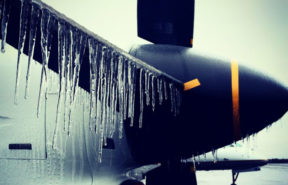December 21, 2005
 On December 21, 2005, the Federal Aviation Administration (FAA) issued a reminder to airlines, charter operators and FAA inspectors that operating in ice pellet conditions with anti-icing fluids on the critical surfaces of an aircraft is contrary to FAA guidance and policy expressed in two FAA Notices:
On December 21, 2005, the Federal Aviation Administration (FAA) issued a reminder to airlines, charter operators and FAA inspectors that operating in ice pellet conditions with anti-icing fluids on the critical surfaces of an aircraft is contrary to FAA guidance and policy expressed in two FAA Notices:
- Notice 8000.309: Dispatching During Precipitation Conditions of Ice Pellets, Snow Pellets, or Other Icing Events for which No Holdover Times Exist (11KB, PDF)
- Notice 8000.313: Parts 121 and 135 Operations Specification for Deicing/Anti-Icing, Operations in Ice Pellets without Deice/Anti-Ice Fluids (31KB, PDF)
The FAA stated that the Agency does not have sufficient data at this time to approve such operations; therefore, such operations are considered to be potentially hazardous. NBAA urges all Part 135 certificate holders to review their flight release procedures and anti-ice/de-ice programs to ensure they are in full compliance with FAA regulations and guidance.
FAA Warning: Anti-Ice/De-Ice Programs – Operating in Ice Pellets and Heavy Snow
It has come to the attention of the Air Transportation Division (AFS-200) that a number of air carrier operators are continuing to dispatch in ice pellet conditions.
Operating in ice pellet conditions with anti-icing fluids on the critical surfaces of an aircraft is contrary to FAA guidance and policy expressed in N8000.309, Dispatching During Precipitation Conditions of Ice Pellets, Snow Pellets, or Other Icing Events for which No Holdover Times Exist, and N8000.313, Parts 121 and 135 Operations Specification for Deicing/Anti-Icing, Operations in Ice Pellets without Deice/Anti-Ice Fluids.
The FAA does not have sufficient data at this time to approve such operations; therefore, without sufficient data, the FAA considers such operations to be potentially hazardous. The regulations allow for departures if the contaminating precipitation is not adhering to the critical surface of the aircraft; a tactile check of the critical surfaces may be necessary to make this assessment under active ice pellet conditions. Therefore, operations in active ice pellet conditions when the ice pellets are adhering to the aircraft critical surfaces, or the aircraft has been treated with anti-icing fluids, is contrary to current FAA guidance and regulations.
Additionally, it has been brought to AFS-200’s attention that some air carrier operators are continuing to depart in heavy snow conditions.
Departing in heavy snow conditions is extremely hazardous. The FAA has provided holdover time (HOT) tables for snow conditions up to moderate intensity. Snow tends to melt rapidly in anti-ice fluids. These fluids may be diluted quickly, resulting in a corresponding rise in the freezing point of the anti-ice fluid. In heavy snow conditions, anti-ice fluids can be expected to fail rapidly (in some cases, the fluid has failed before the aircraft anti-icing process was completed). This event can put a departing aircraft in great jeopardy. There should be no air carrier deicing/anti-icing programs that allow for departures in heavy snow conditions.
AFS-200 has also received reports that some deicing/anti-icing contract service providers are failing to deice aircraft properly (e.g., not removing ice or snow from engine inlets, etc.). Air carrier operators should be reminded that they, the air carrier operators, are responsible for the proper deicing/anti-icing of their aircraft and that they should take the necessary actions to assure that their aircraft are being deiced/ant-iced in accordance with their program.
Flight standards field offices should monitor their air carriers for compliance with the current deicing/anti-icing guidance and regulations.
Air carriers may be subject to enforcement action if they do not comply with appropriate deicing/anti-icing regulatory guidelines.
If you have any questions on this matter, contact AFS-200 at (202) 267-8166 or by e-mail at: daniel.meier@faa.gov.


 International Business Aviation Council Ltd.
International Business Aviation Council Ltd.